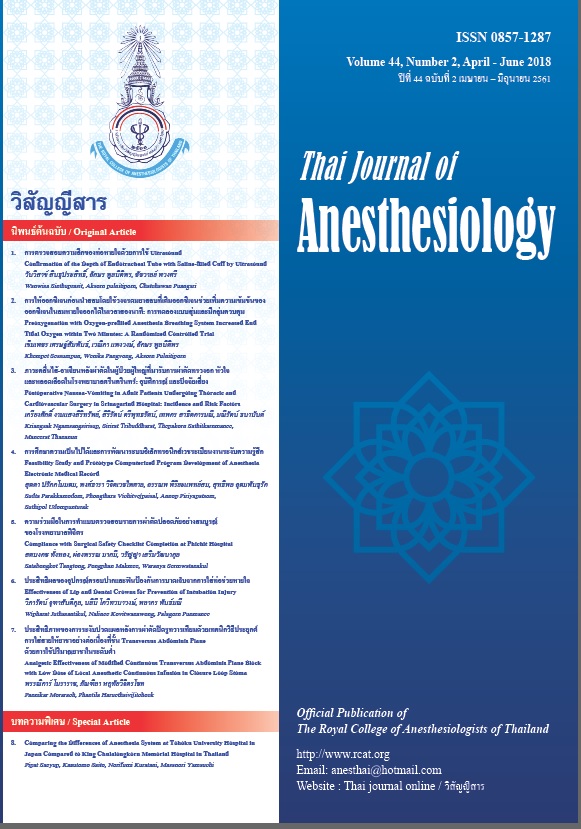Confirmation of the Depth of Endotracheal Tube with Saline-filled Cuff by Ultrasound
Main Article Content
Abstract
Background: Malposition of endotracheal tube can lead to serious complications, so positioning the endotracheal tip
4 cm above carina was recommended. Tracheal ultrasound with saline-filled endotracheal cuff has been used to confirm endotracheal position because it’s simple, safe and reproducible. We aimed to find the distance between lower border of cricoid cartilage and upper border of endotracheal cuff which the tip of endotracheal tube was placed 4 cm above carina using ultrasound-guided.
Methods: The study was conducted on 18-65 years old patients, ASA I and II undergoing elective surgery under general anesthesia with endotracheal tube intubation. After the endotracheal tube was inserted, the position of the tip of endotracheal tube was adjusted to 4 cm above carina by using fiberoptic bronchoscope then the endotracheal cuff was filled with saline 7 ml. The distance between lower border of cricoid cartilage and upper border of endotracheal cuff was measured by longitudinal tracheal ultrasonography. Data were reported as mean±SD
Results: One hundred and thirty two patients were enrolled. The mean distance between lower border of cricoid cartilage and upper border of endotracheal cuff was 1.17±0.49 cm, 1.19±0.52 cm and 1.15±0.47 cm in all population, male and female, respectively.
Conclusions: The measurement distance between lower border of cricoid cartilage and upper border of saline-filled endotracheal cuff by ultrasound can be used as another modality to optimize the proper position of endotracheal tube.
Article Details
References
Bissinger U, Lenz G, Kuhn W. Unrecognized endobronchial intubation of emergency patients. Ann Emerg Med 1989;18:853-5.
2.
Owen RL, Cheney FW. Endobronchial intubation: a preventable complication. Anesthesiology 1987; 67: 255-7.
3.
Clyburn P, Rosen M. Accidental oesophageal intubation. Br J Anaesth 1994;73:55-63.
4.
Goodman LR, Conrardy PA, Laing F, et al. Radiographic evaluation of endotracheal tube position. Am J Roentgenol 1976;127:433-4.
5.
Sitzwohl C, Langheinrich A, Schober A, et al. Endobronchial intubation detected by insertion depth of endotracheal tube, bilateral auscultation, or observation of chest movements: randomised trial. BMJ 2010;341:c5943.
6.
Li J. Capnography alone is imperfect for endotracheal tube placement confirmation during emergency intubation. J Emerg Med 2001;20:223-9.
7.
Raphael DT, Conard FU. Ultrasound confirmation of endotracheal tube placement. J Clin Ultrasound 1987;15: 459-62.
8.
Rudraraju P, Eisen LA. Confirmation of endotracheal tube position: a narrative review. J Intensive Care Med 2009; 24:283-92.
9.
Chou HC, Tseng WP, Wang CH, et al. Tracheal rapid ultrasound exam (T.R.U.E.) for confirming endotracheal tube placement during emergency intubation. Resuscitation 2011;82:1279-84.
10.
Sagˇ lam C, U ¨ nlu¨ er EE, Karago¨ z A. Confirmation of endotracheal tube position during resuscitation by bedside ultrasonography. Am J Emerg Med 2013;31:248-50.
11.
Mitchell V, Adams T, Calder I. Choice of cuff inflation medium during nitrous oxide anaesthesia. Anaesthesia 1999; 54:32-6.
12.
Mark O. Tessaro, Alexander C. Arroyo, Lawrence E. Haines, Eitan Dickman, Inflating the endotracheal tube cuff with saline to confirm correct depth using bedside ultrasonography. CJEM 2015;17(1):94-98.
13.
Uya A, Spear D, Patel K, et al. Can novice sonographers accurately locate an endotracheal tube with a saline-filled cuff in a cadaver model? A pilot study. Acad Emerg Med 2013; 19:361-4.
14.
Pollard RJ, Lobato EB. Endotracheal tube location verified reliably by cuff palpation. Anesth Analg 1995;81:135-8.
15.
Stone DJ, Gal TJ. Airway Management. In: Miller RD, Cucchiara RF, Miller ED. Editors. Miller’s Anesthesia. 6th ed. Philadelphia: Elsevier Churchill Livingstone; 2005. p. 1431-2.


